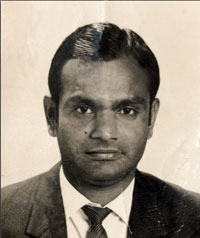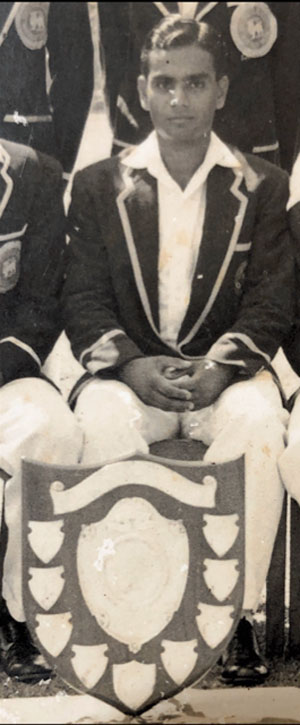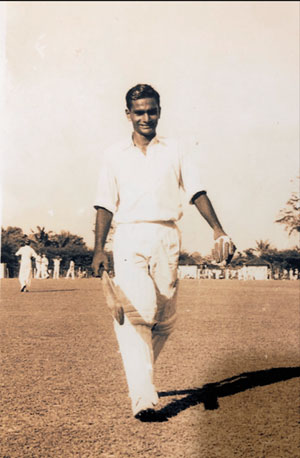Carlyle Perera: Doyen of University Cricket
View(s):Carlyle Perera of St. Joseph’s College and University of Ceylon was a gifted cricketer, well known in cricket circles in the 1950s and 60s. He left his imprint on University cricket by winning the Saravanamuttu Cricket Trophy in 1962-63. It was a unique achievement, for not only did he wrest the trophy from the monopolistic control of established clubs, but also created a record by achieving a feat unrivalled before or after by the University.
 Carlyle reached such dizzy heights with a band of exceptionally talented schoolboy cricketers who had gained admission to the university. It was an era when cricket was more a pastime than a fulltime commitment. But a change came after the country received Test status. Cricket was earlier played to give expression to passion and enjoyment, to evoke praise and appreciation for display of talent, and to gain recognition. Money was yet to enter the fray to tilt the balance.
Carlyle reached such dizzy heights with a band of exceptionally talented schoolboy cricketers who had gained admission to the university. It was an era when cricket was more a pastime than a fulltime commitment. But a change came after the country received Test status. Cricket was earlier played to give expression to passion and enjoyment, to evoke praise and appreciation for display of talent, and to gain recognition. Money was yet to enter the fray to tilt the balance.
Therefore, before the transition in the divide, with nothing but recognition being the only reward or compensation for excellence, schoolboy cricketers often sought to secure their future by commitment to studies. Others looked for gainful employment to face future challenges of life. Two examples come to mind. L.R. Gunatillake, the speedster in the 1950s and 60s, was arguably one of the best fast bowlers, if not the very best, to have graced the national scene. But at the summit of success, he opted for employment out of Colombo. His loss was also the country’s loss. It was therefore a period when more time was spent on studies and gainful employment, and less on cricket. Stability of the future and a rewarding profession or means of income predominated time and exertions required for the game.
On the other side of the divide when money came to influence the game, cricket as a discipline became highly challenging and competitive. Therefore, considerable time had to be devoted for practices and matches. Inevitably, cricket became both a passion and a serious profession. With more devotion to the game, there was less time for studies or practicing professions seriously. Those who carved big names, were amply compensated, for cricket was more lucrative than employment. Kumar Sangakkara epitomised the period after the transition. He was equipped to emerge as an eminent lawyer, but wisely preferred to devote time to his exceptional skills in cricket, to emerge as one of the best batsmen in the world. He therefore gained both opulence and fame.
The university was blessed with a galaxy of outstanding cricketers in the 1950s and 60s. But they epitomised the breed before the divide or the transition. They spent more time on studies, and less on the game, to prepare for the challenges of life. One could only conjecture how they would have performed after the transition, amidst attractive enticements.
Scarcity of space constrain a narrative of a large number of names that come to mind, but at least some of them deserve mention; Carlyle Perera, H.I.K. Fernando, D.H. de Silva, Buddy Reid, Brendon Gooneratne, Mano Ponniah, Lareef Idroos, Ranjit Doranegama, Cyril Ernest, Nihal Gurusinghe, Raja de Silva, Priya Perera, Neil Chanmugam, Mohanlal Fernando, Kingsley Fernando, Skandakumar, Malsiri Kurukulasooriya, Anton Rambukpota, Michael Roberts, Sarath Wimalaratne and Sarath Seneviratne. There were many more. The list would be endless.
To my recollection, University of Ceylon came third in the ‘Sara’ Trophy Tournaments of 1960-61 and 1961-62. Carlyle Perera was the vice captain in 1961-62 to Brendon Gooneratne. Mano Ponniah, Lareef Idroos, Cyril Ernest, Kingsley Fernando, Harsha Samarajiva, N.J.S. de Mel and Sivanandan, well known for their prodigious feats as schoolboys, entered the university in 1961-62.
Carlyle took over the reins of leadership in 1962-63. He had lost reputed seniors from the team of the previous year: Brendon Gooneratne, Priya Perera and Neil Chanmugam amongst others. I too had opted out of cricket to prepare for the final exam, since travelling to and from Peradeniya, disturbed preparations for the exam. I however played just one match, against SSC, on a request from Carlyle to try and capture the wicket of Ivers Gunasekara, having done so thrice previously. Carlyle led the relatively raw, untested team to the pinnacle of success, and carved an indelible niche in the annals of university cricket by winning the championship trophy. Buddy Reid was the ideal vice captain to him, both working ‘in tandem’.
The performances of established players, Buddy Reid, Nihal Gurusinghe, U.R.P. Gunatillaka, Mohanlal Fernando, Ernest and Idroos were not exactly outstanding in the previous year. Besides, players of the calibre of Ponniah, Idroos, Nanda Senanayake, Samarajiva, Ernest and Kingsley Fernando did not acquire permanent positions in 1961-62. Perhaps the senior players could not be omitted to make way for them, or their talent and potential had not been fully recognised and harnessed.
Carlyle, as captain, transformed them from good players to ‘giants’. Reid, Ponniah, Gurusinghe, Ernest, Nanda Senanayake, N.J.S. de Mel, U.R.P. Gunatillake and Kingsley Fernando scored heavily, whilst the three allrounders, Idroos, Ernest and Mohanlal Fernando excelled with both bat and ball. Mohanlal had been my opening bowling mate in the previous years, but bowling with venom and hostility, he was an entirely different bowler in 1962-63 under the inspiring leadership of Carlyle.
Allrounders Mohanlal Fernando, Idroos and Ernest excelled consistently to be the envy of many clubs, for it was uncommon for them to boast of such a luxury of gifted allrounders. The prodigious performances of Reid, Mohanlal Fernando, Idroos, Ponniah, Ernest and Nihal Gurusinghe were rewarded, with all of them being selected to represent either Ceylon or CCA (Ceylon Cricket Association). Ponniah proceeded to Cambridge and performed with panache, partnering Mike Brearley as opener.
On assuming the captaincy, Carlyle set himself the target of becoming champions in the tournament, and drilled his team to work towards it. He requested his players to abandon their carefree approach to the game, spend more time at practices despite studies, regain fitness, and practice fielding intensely. He infused confidence in each and every player. He made them trust their yet hidden, untapped potential. He changed the mindset of his players by constantly coaxing them to perform better. He dangled the carrot and wielded the stick, and made the team a cohesive, well-knit team.
As matches progressed, performances prospered and confidence abounded, the team developed a type of fighting spirit alien to many competing clubs. They often fought tooth and nail to wriggle out of situations. Carlyle converted a relatively untested group of players to a formidable outfit that became the cynosure of adoring spectators. The players reached a point in thinking that they could surmount any challenge. It is not often that a group of players which made a modest impact in the previous year, could emerge as ‘greats’ within just one year; and for some of them to gain national recognition. Carlyle had no material benefits to offer to bait his players but only words of inspiration, sincerity, and exemplary leadership. He was yet a mere student amongst students. He was also a martinet, but only when necessary.
Carlyle’s inestimable worth as a leader was confirmed by the inability of the university to reach ‘cup glory’ before 62-63 or after. He was also skilful in tactics and strategy, working in concert with Buddy Reid. They meticulously sat and planned tactics against opposition batsmen and bowlers before each match. Carlyle’s obsession and unwavering commitment influenced the entire team. It was as if he had cast a benevolent spell over his players. Carlyle was in actual fact, captain, coach and manager of the side, blending all roles into one. He found his true métier in leadership, planning strategies, and management. Posterity has to recognise Carlyle Perera as the undisputed doyen of University Cricket, for his unique achievement will remain an undimmed beacon in its history.
Merril Gunaratne
Writer can be contacted at mmgunaratne@gmail.com


